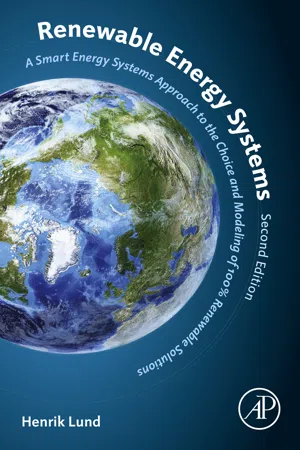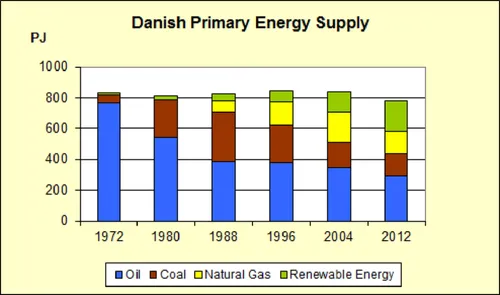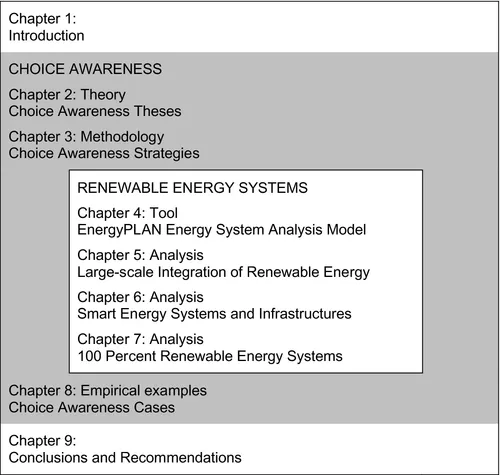
eBook - ePub
Renewable Energy Systems
A Smart Energy Systems Approach to the Choice and Modeling of 100% Renewable Solutions
- 384 pages
- English
- ePUB (mobile friendly)
- Available on iOS & Android
eBook - ePub
Renewable Energy Systems
A Smart Energy Systems Approach to the Choice and Modeling of 100% Renewable Solutions
About this book
In this new edition of Renewable Energy Systems, globally recognized renewable energy researcher and professor, Henrik Lund, sets forth a straightforward, comprehensive methodology for comparing different energy systems' abilities to integrate fluctuating and intermittent renewable energy sources. The book does this by presenting an energy system analysis methodology.
The book provides the results of more than fifteen comprehensive energy system analysis studies, examines the large-scale integration of renewable energy into the present system, and presents concrete design examples derived from a dozen renewable energy systems around the globe. Renewable Energy Systems, Second Edition also undertakes the socio-political realities governing the implementation of renewable energy systems by introducing a theoretical framework approach aimed at understanding how major technological changes, such as renewable energy, can be implemented at both the national and international levels.
- Provides an introduction to the technical design of renewable energy systems
- Demonstrates how to analyze the feasibility and efficiency of large-scale systems to help implementers avoid costly trial and error
- Addresses the socio-political challenge of implementing the shift to renewables
- Features a dozen extensive case studies from around the globe that provide real-world templates for new installations
Frequently asked questions
Yes, you can cancel anytime from the Subscription tab in your account settings on the Perlego website. Your subscription will stay active until the end of your current billing period. Learn how to cancel your subscription.
At the moment all of our mobile-responsive ePub books are available to download via the app. Most of our PDFs are also available to download and we're working on making the final remaining ones downloadable now. Learn more here.
Perlego offers two plans: Essential and Complete
- Essential is ideal for learners and professionals who enjoy exploring a wide range of subjects. Access the Essential Library with 800,000+ trusted titles and best-sellers across business, personal growth, and the humanities. Includes unlimited reading time and Standard Read Aloud voice.
- Complete: Perfect for advanced learners and researchers needing full, unrestricted access. Unlock 1.4M+ books across hundreds of subjects, including academic and specialized titles. The Complete Plan also includes advanced features like Premium Read Aloud and Research Assistant.
We are an online textbook subscription service, where you can get access to an entire online library for less than the price of a single book per month. With over 1 million books across 1000+ topics, we’ve got you covered! Learn more here.
Look out for the read-aloud symbol on your next book to see if you can listen to it. The read-aloud tool reads text aloud for you, highlighting the text as it is being read. You can pause it, speed it up and slow it down. Learn more here.
Yes! You can use the Perlego app on both iOS or Android devices to read anytime, anywhere — even offline. Perfect for commutes or when you’re on the go.
Please note we cannot support devices running on iOS 13 and Android 7 or earlier. Learn more about using the app.
Please note we cannot support devices running on iOS 13 and Android 7 or earlier. Learn more about using the app.
Yes, you can access Renewable Energy Systems by Henrik Lund in PDF and/or ePUB format, as well as other popular books in Technology & Engineering & Industrial Engineering. We have over one million books available in our catalogue for you to explore.
Information
Chapter 1
Introduction
Abstract
This chapter introduces the theme set by the question How can society convert to 100 percent renewable energy? Two important aspects must be considered. First, from a technical point of view, which technologies can we use and how can we design coherent and smart renewable energy solutions? Second, in terms of politics and social science, how can society implement such a technological change? The answer involves the formulation of the Choice Awareness theory, and this chapter formally defines the following concepts: choice awareness, radical technological change, applied and concrete economics, renewable energy, and smart energy systems. Finally, it discusses the term of sustainable energy versus renewable energy.
Key Words
applied economics
Choice Awareness
concrete economics
institutional economics
radical technological change
renewable energy
renewable energy systems
smart energy
smart energy systems
How can society convert to 100 percent renewable energy? The answer to that question is the main topic of this book. Two important aspects must be considered. First, from a technical point of view, which technologies can we use to make sure that the resources available meet the demands? To answer this question, this book presents an energy system analysis methodology and a tool for the design of renewable energy systems. This part includes the results of more than 15 comprehensive energy system analysis studies. The large-scale integration of renewable energy into the present system has been analyzed, as well as the implementation of 100 percent renewable energy systems. Moreover, as part of this new edition, a chapter on Smart Energy Systems and Infrastructures has been added (Chapter 6).
Second, in terms of politics and social science, how can society implement such a technological change? To answer that question, this book introduces a theoretical framework approach, which aims at understanding how major technological changes, such as renewable energy, can be implemented at both the national and international levels. This second aspect involves the formulation of the Choice Awareness theory, as well as the analysis of 11 major empirical cases from Denmark and other countries.
Regarding the implementation of the change from fossil fuels to renewable energy, Denmark is an interesting case. Like many other Western countries, Denmark was totally dependent on the import of oil at the time of the first oil crisis in 1973. Almost all transportation and residential heating were based on oil. Furthermore, 85 percent of the electricity supplied in Denmark was produced from oil. Altogether, prior to the oil crisis, more than 90 percent of its primary energy supply was based on oil.
Denmark, like many other countries, was unprepared for the sudden rise in oil prices. Danish energy planning had been based on the principle of supply meeting demand. Power stations were planned and built on a prognosis based on the historical development of needs. Denmark had no minister of energy and no energy department, no action plans in the case of being cut off from oil supplies, and no long-term strategy for the future in case oil resources were depleted.
Nevertheless, now 40 years later, Danish society has proved its ability to implement rather remarkable changes. Figure 1.1 shows the development of the primary energy supply of Denmark since 1972 and illustrates two important factors: half of the oil consumption has been replaced by other fuels—for example, coal, natural gas, and, to some extent, renewable energy—and Denmark has managed to stabilize the primary energy supply at the same level as in 1972. This stabilization is unique compared to other countries, as it has been achieved simultaneously with a “normal western European” economic growth.

Figure 1.1 Danish primary energy supply.
The primary means have been energy conservation and efficiency improvements in the supply. Buildings have been insulated, and combined heat and power (CHP) production has been expanded. Thus, 40 years later, the primary energy supply for heating has been reduced to two-thirds of what was used prior to 1973, even though the heated space area has increased by more than 50 percent in the same period. The renewable energy share of the primary energy supply has increased from around zero in 1972 to more than 20 percent in 2012, and wind power production has grown to more than a 25 percent share of the electricity demand.
Since 2006, the target of the Danish Government has been that Denmark will become completely fossil fuel free. Since the first edition of this book was published, Denmark has defined a target of using 100 percent renewable energy in its energy and transportation sectors by 2050. In March 2012, a new political agreement constituting an important step toward fulfilling the 2050 target was reached by 95 percent of the members of Parliament. By 2020, the agreement will, among other initiatives, increase the share of renewable energy in the final energy consumption to more than 35 percent; increase the share of wind power to approximately 50 percent of the electricity demand; and reduce greenhouse gas emissions by 34 percent compared to 1990 (Danish Energy Agency 2012).
Moreover, Denmark started to produce oil and natural gas from the North Sea in the early 1980s and has, since 1997, been more than self-supplied with energy. However, the Danish oil and gas resources are scarce and are likely to last for only a few decades. Can Denmark convert to 100 percent renewable energy within a few decades, or will it have to return once again to the former dependence on imported fossil fuels? This question is indeed relevant not only to Denmark but to Europe in general as well as the United States, China, and many other nations around the world.
The idea of this book is to unify the results and deduce the learning of a number of separate studies and thereby contribute to a coherent understanding of how society can implement renewable energy systems. The book is based on 25 years of involvement in a number of important and representative political decision-making processes in Denmark and other countries. As we will see, these processes reveal the lack of ability of organizations and institutions linked to existing technologies to produce and promote proposals and alternatives based on radical changes in technology.
On the other hand, the stabilization of the primary energy supply shown in Figure 1.1 proves that the ability to act as a society has been possible, despite conflicts with representatives of the old technologies. In Denmark, during this period, official energy objectives and plans have been developed due to a constant interaction between Parliament and public participation. In this interaction, the description of new technologies and alternative energy plans has played an important role.
The theory of Choice Awareness seeks to understand and explain why the best alternatives are not described and developed per se and what can be done about it. Choice Awareness theory argues that public participation, and thus the awareness of choices, has been an important factor in successful decision-making processes and puts forward four strategies to help along these processes.
1 Book contents and structure
Figure 1.2 shows the structure of this book. The Choice Awareness section (the gray area) includes a theoretical understanding and a framework for the development of renewable energy system analysis tools and methodologies (the white area). This chapter introduces both aspects and provides some important definitions.

Figure 1.2 Contents and overall structure of the book.
Chapter 2 introduces the Choice Awareness theory, which deals with how to implement radical technological changes such as renewable energy systems. This theory argues that the perception of reality and the interests of existing organizations will influence the societal perception of choices. Often these organizations seek to hinder radical institutional changes by which they expect to lose power and influence. Choice Awareness theory states that one key factor in this manifestation is the societal perception of having either a choice or no choice.
The Choice Awareness theory presents two theses. The first states that when society defines and wishes to implement objectives implying radical technological change, existing organizations will often seek to create the perception that the radical change in technologies is not an option and that society has no choice but to implement a solution involving the technologies that will save and constitute existing positions. The second thesis argues that, in such a situation, society will benefit from focusing on Choice Awareness, that is, raising the awareness that alternatives do exist and that it is possible to make a choice. Four key strategies are identified from which society will benefit when seeking to raise Choice Awareness.
Chapter 3 elaborates on the Choice Awareness strategies related to the second thesis: the design of concrete technical alternatives, feasibility studies based on institutional economic thinking, the design of public regulation measures, and the promotion of a democratic infrastructure based on new corporative regulation.
Chapter 4 describes the method of designing concrete technical alternatives based on renewable energy technologies. This method distinguishes between three implementation phases: introduction, large-scale integration, and 100 percent renewable energy systems. The need for simulation tools in the two latter phases is especially emphasized. Both methodology and tool development are discussed in relation to the theoretical framework of Choice Awareness, and the energy system analysis tool, EnergyPLAN, is described. The EnergyPLAN model is a freeware that can be accessed from the home page, www.EnergyPLAN.eu, together with documentation and a training program.
Chapter 5 refers to and deduces the essence of a wide range of studies of the Danish energy system. In these studies, the EnergyPLAN model has been applied to the analysis of large-scale integration of renewable energy. The Danish energy system is characterized by a high share of renewable energy and is therefore a suitable case for the analysis of further large-scale integration. The question in focus is how to design energy systems with a high capability of utilizing intermittent renewable energy sources. This chapter describes important methodology developments and compares the capability of different systems, including how they treat the fact that the fluctuations and intermittence of, for example, wind power differ from one year to another.
Chapter 6 adds to the previous chapter by focusing on infrastructures and introduces the term Smart Energy Systems. In recent years, ...
Table of contents
- Cover image
- Title page
- Table of Contents
- Copyright
- Acknowledgments
- About the Contributors
- Abbreviations
- Chapter 1: Introduction
- Chapter 2: Theory: Choice Awareness Theses
- Chapter 3: Methodology: Choice Awareness Strategies
- Chapter 4: Tool: The EnergyPLAN Energy System Analysis Model
- Chapter 5: Analysis: Large-Scale Integration of Renewable Energy
- Chapter 6: Analysis: Smart Energy Systems and Infrastructures
- Chapter 7: Analysis: 100 Percent Renewable Energy Systems
- Chapter 8: Empirical Examples: Choice Awareness Cases
- Chapter 9: Conclusions and Recommendations
- Bibliography
- Index